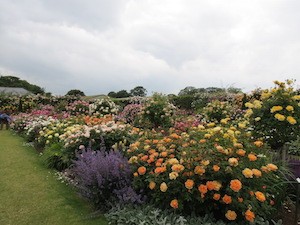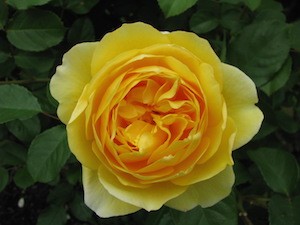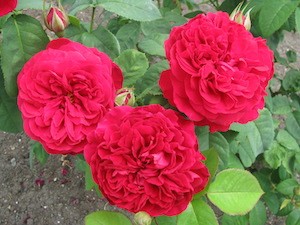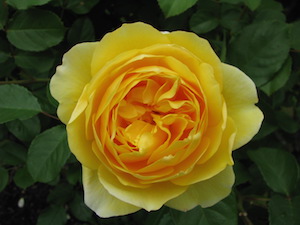 One of the success stories from the rose world over the past 30 years has been the rise of the English Roses or those roses bred by David Austin in England. They are know grown widely all over the world and at a time when rose sales have generally declined, they have continued to sell well and attract the attention of the public.
One of the success stories from the rose world over the past 30 years has been the rise of the English Roses or those roses bred by David Austin in England. They are know grown widely all over the world and at a time when rose sales have generally declined, they have continued to sell well and attract the attention of the public.
David Austin first began breeding roses as a hobby in the early 1960’s near the village of Albrighton in Shropshire. His breeding aims then are much the same today – combine the form and scent of heritage roses with the repeat flowering and colour range of modern roses.
The first varieties released were not strong or healthy growers so further breeding led to these limitations being overcome. With Hybrid Teas and Floribundas being so popular, David Austin set up his own nursery in 1969 to sell his own roses.
Over the 50 odd years that David Austin has bred roses, more than 220 varieties have been introduced to rose lovers worldwide, not all of these have made it to New Zealand but we still have a great selection to choose from. Many of the earlier varieties have been superseded by newer varieties which have greatly improved disease tolerance.
David Austin varieties are available in a range of colours from deep crimsons and purples through to pure whites, coppery orange shades and pastels. Bloom form is typically double and packed with petals, although there are some beautiful single David Austin varieties available. And of course, almost all are fragrant, some lightly but most moderate to strongly fragrant varieties that all rose lovers will appreciate. David Austin has also improved the health of his varieties over the years and many of the newer varieties have great health.
From David Austin working alone, there is a team of 15 in the rose breeding department at David Austin creating 150,000 new seedlings each year. Only the best few will make it to market and Austin varieties are sold all around the world and grown in many public and private gardens.
David Austin’s own garden located at the company’s headquarters in England attracts thousands of visitors a year to see the magnificent garden which I visited in late June this year. I rate it as the best I have seen and a great advertisement for English roses both the individual varieties and how to use them. David Austin varieties combine very well with other roses and other garden plants in almost any situation. Some can be used as climbers to provide vertical interest and colour while others are great for borders, hedges and even in containers.
Some of the more popular David Austin varieties;
 ‘Graham Thomas’ (Ausmus). Named for the famous gardener, this variety is the most well-known of all the English varieties. In New Zealand, it is best grown as a climber. The rich yellow flowers have a good fragrance. Voted into the World Federation of Rose Societies Hall of Fame in 2009.
‘Graham Thomas’ (Ausmus). Named for the famous gardener, this variety is the most well-known of all the English varieties. In New Zealand, it is best grown as a climber. The rich yellow flowers have a good fragrance. Voted into the World Federation of Rose Societies Hall of Fame in 2009.
‘Mary Rose’ (Ausmary) Named for Henry VIII’S flagship, this rose pink English variety has stood the test of time since its first release in the 1980’s. Bushy, with twiggy growth, the blooms are strongly scented. It’s white sport ‘Winchester Cathedral’ (Auscat) is just as good with white coloured blooms.
 ‘L.D. Braithwaite’ (Auscrim) The best David Austin variety in New Zealand conditions. Not the most fragrant of English roses but for all round performance, it cannot be beaten and is stunning in full bloom with large crimson blooms.
‘L.D. Braithwaite’ (Auscrim) The best David Austin variety in New Zealand conditions. Not the most fragrant of English roses but for all round performance, it cannot be beaten and is stunning in full bloom with large crimson blooms.
‘Golden Celebration’ (Ausgold) is another deep golden yellow variety that appeals to many because of its name. Large cupped blooms have a great scent and can be grown as a shrub or short climber.
‘Munstead Wood’ (Ausbernard) is one of the newer varieties that is proving to be very popular. The deep velvety crimson blooms are strongly scented and the compact plant has great disease tolerance.
Two new varieties that have been introduced to New Zealand this year are ‘Princess Anne’ (Auskitchen) a pure deep pink, extremely healthy variety and ‘England’s Rose’ (Auslounge) a glowing pink, free flowering variety.
In the rose garden in October
– Keep an eye on newly planted bushes if there is no rain, they may need a water.
– Check bushes for any dieback appearing – cut this out if it does
– Pests such as aphids and diseases like blackspot and downy mildew will be appearing if weather conditions are right. Time to get on a preventative spray onto the foliage – your local garden centre can advise on what you can use
– If not done already, fertilise and mulch your plants. Mulching is great as it keeps the moisture in, keeps the weeds down and improves the appearance of your garden.
– Stake any basal shoots (new shoots that appear from the base of the plant) to protect against damage by strong winds.
By Hayden Foulds. Read more here.
www.nzroses.org.nz
Twitter @nzroses
Facebook: facebook.com/nzroses









Stephanie - 10 years ago
Roses cascading,delighting the eye with their beauty as they cast their fragrances about with glorious abandon.Oh……a girl can dream…..